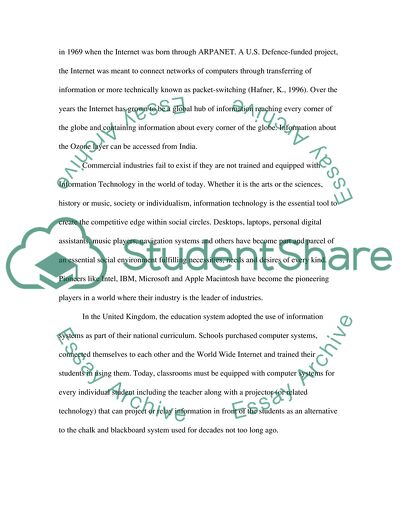
- Home
- Free Samples
- Premium Essays
- Editing Services
- Extra Tools
- Essay Writing Help
- About Us
- Studentshare
- Subjects
- Miscellaneous
- Information Technology determines contemporary social change. Discuss giving examples
Information Technology determines contemporary social change. Discuss giving examples - Essay Example

- Subject: Miscellaneous
- Type: Essay
- Level: Undergraduate
- Pages: 4 (1000 words)
- Downloads: 0
- Author: nfadel
Extract of sample "Information Technology determines contemporary social change. Discuss giving examples"
Early information technology systems relied on bulky and expensive equipment, slow processing speeds and overall high maintenance costs. Data storage was laborious and had to be stored immediately increasing storage costs considerably. Paper tapes, magnetic tapes and punched cards would be processed in batch-processing fashions that were very symbolic of information processing at the time (Campbell-Kelly, M., 1989). Heavy use of paper was still being utilized – a contradiction to the existence of computers.
Only large and successful corporations could invest in such heavy ‘machinery’ for direct, indirect and processing costs were too high for small businesses. Within a span of two to three decades, computers had crept into the world of small businesses and were making a head start as personalized computers at home. It was in 1969 when the Internet was born through ARPANET. A U.S. Defence-funded project, the Internet was meant to connect networks of computers through transferring of information or more technically known as packet-switching (Hafner, K., 1996). Over the years the Internet has grown to be a global hub of information reaching every corner of the globe and containing information about every corner of the globe.
Information about the Ozone layer can be accessed from India. Commercial industries fail to exist if they are not trained and equipped with Information Technology in the world of today. Whether it is the arts or the sciences, history or music, society or individualism, information technology is the essential tool to create the competitive edge within social circles. Desktops, laptops, personal digital assistants, music players, navigation systems and others have become part and parcel of an essential social environment fulfilling necessities, needs and desires of every kind.
Pioneers like Intel, IBM, Microsoft and Apple
...Download file to see next pages Read MoreCHECK THESE SAMPLES OF Information Technology determines contemporary social change. Discuss giving examples
Impact of information technology on Hotel Business
Culture Is Media and Media Is Culture
Society, Ethics and Technology
IT to Determine Social Change
Information Technology Determines Contemporary Social Change
Contemporary Culture and Its Effects
Technological Determinism
The Discourse on Information Society - Theorising the Nature and Path of Information Society

- TERMS & CONDITIONS
- PRIVACY POLICY
- COOKIES POLICY